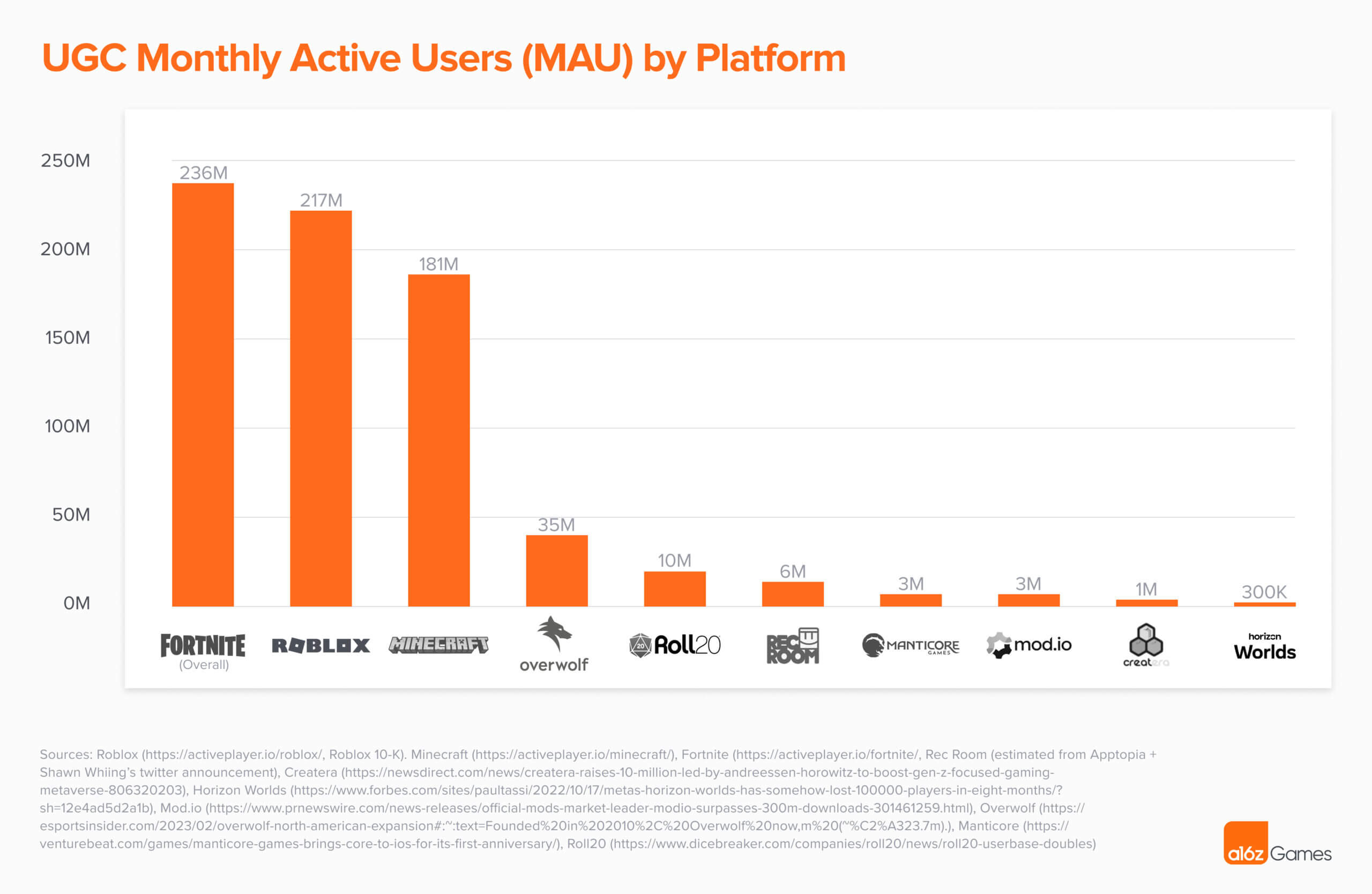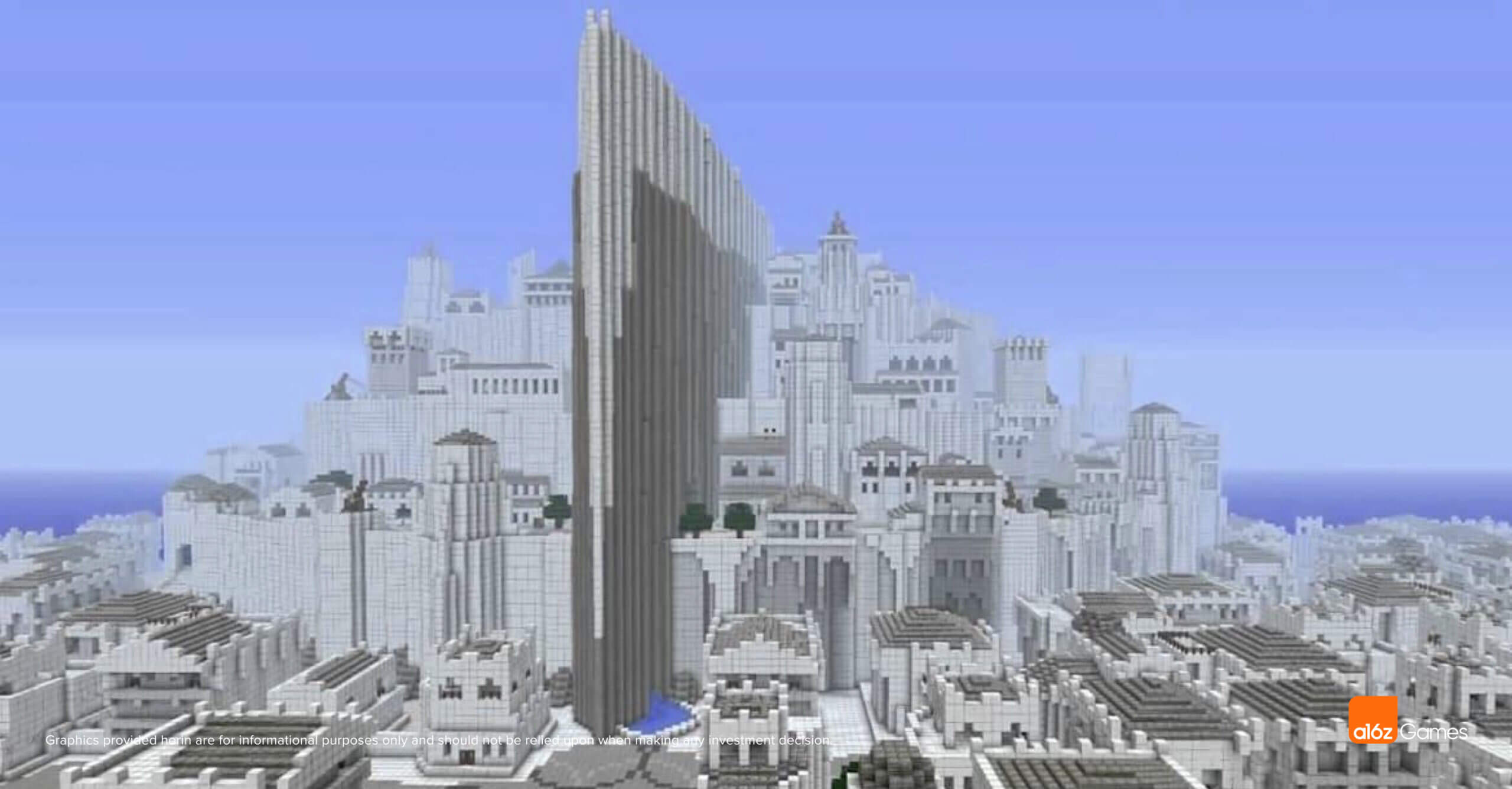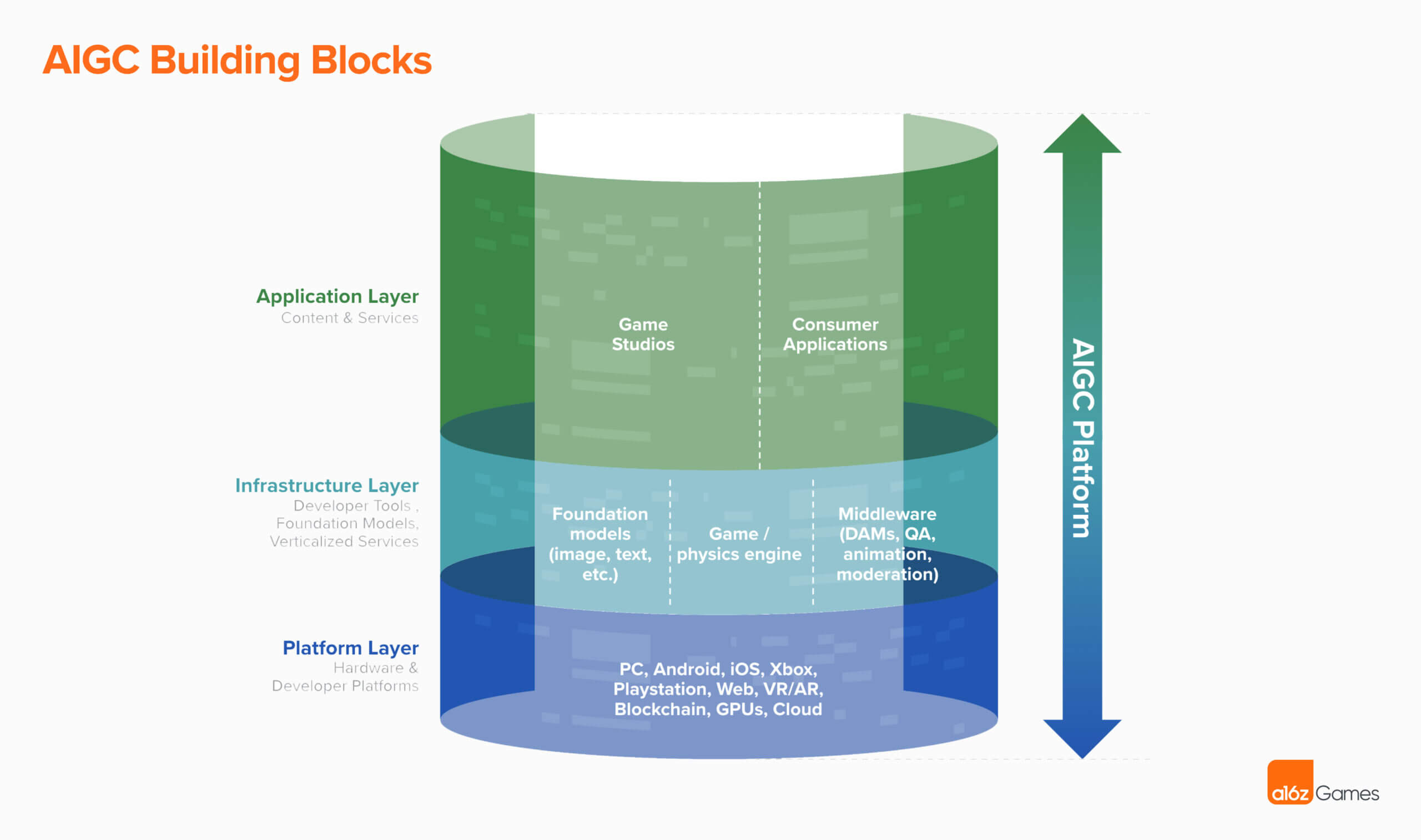As the Generative AI Revolution in Games progresses, it will completely reshape User Generated Content (UGC) creating a world where anyone can build games and expanding the games market beyond what many thought was possible. In the coming years, deep technical knowledge or artistic mastery will no longer be essential skills needed to develop games; instead, creators will be limited only by their energy, creativity, and imagination. Ideas won’t be cheap; they’ll be precious. Most importantly, game creation will become truly democratized and millions of new game-makers will be minted.
Ideas are cheap. It’s only what you do with them that counts. – Isaac Asimov
Based on the history of UGC platforms, the recent availability of consumer-facing LLMs, and observations about previous technological shifts, we believe that the evolution from UGC games to AI-powered UGC (what we’ll refer to hereafter as AIGC) will occur in two phases.
- The first phase will focus on tooling. Generative AI will likely act as a co-pilot to human creators by making existing UGC workflows more powerful and accessible. Incumbent UGC platforms (i.e. Roblox) will add generative AI tools to their existing toolsets, and startups will emerge to replicate current UGC workflows but optimized for generative AI from the start. Similar to how the internet originally started to solve minor point solutions for the government, or how the cloud was used for point solutions to start, we believe that generative AI will start with point solution tools to assist creators in their current workflow.
- In the second phase, we believe new companies will arise that reimagine creation workflows from the ground up. It’s likely products in phase two will look less like tools or platforms and more like engines or operating systems built foundationally with generative AI. Similar to how the winning websites weren’t imitations of newspapers or how the winning mobile apps weren’t emulations of websites, we believe that an entirely new paradigm of creation will emerge with generative AI embedded deep into the foundational stack from UX to rendering pipelines. Exactly what form they’ll take now, no one can truly predict.
In this blog post we’ll cover the history of and lessons learned from existing UGC platforms, a market map of where UGC companies are today and a framework to think about them, what we expect companies to be building and how they will compete in AIGC’s first phase (AI-powered tooling), and how companies might emerge in AIGC’s second phase (AI-powered engines).
TABLE OF CONTENTS
Current State of UGC Platforms
TABLE OF CONTENTS
The world of gaming has undergone a tectonic shift in recent years with the rise of UGC platforms like Roblox and Minecraft (56M DAU and 17M DAU respectively). These platforms have enabled millions of people to experience the thrill and challenge of making virtual experiences and games for others by making creation tools more accessible. The games built have scaled with the power of the tools, now rivaling professional development teams (see gameplay from Roblox Ultimate Paintball vs. January’s Roblox Frontlines below).
How did these two platforms become dominant players in the UGC space? Under the hood, Roblox and Minecraft are very different products and they took very different paths to grow. Both, however, are rooted in the history of video game mods – dating back to the community of hackers that just wanted to bring their own ideas to life in the games they loved.
One of the first popular mods was Castle Smurfenstein in the early 1980s, a mod of Id Software’s popular Castle Wolfenstein game. Id followed with the release of Doom in 1993, which included a WAD file package for Doom’s maps, sprites, textures, assets, etc. And of course, there’s Counter-strike, the most popular mod for Valve’s Half Life, and Defense of the Ancients, itself a mod of the popular Warcraft game and the precursor for Riot’s League of Legends. The tradition is still well and alive today; Skyrim, a game that launched in 2011, has over 60K mods with billions of downloads.
Mods require a more sophisticated understanding of the game’s underlying architecture and programming, but Roblox and Minecraft simplified and abstracted the game creation process. Roblox launched in 2006 as a UGC games platform for younger children, spawned by founder David Baszucki’s insight that some of the educational physics tools he built were used to create games. Roblox was designed to be composable, with shape primitives imitating lego blocks and a simpler scripting language in Lua. In comparison, Minecraft drew players into its creator loop through its core building and survival gameplay. Minecraft started in 2009 as a simple indie game called “Cave Game,” created by Swedish programmer Markus “Notch” Persson, who drew inspiration from base-building and block-mining games. As the Minecraft tooling became more powerful, players created grand cityscapes like this one of Minas Tirith from The Lord of the Rings.
There are a few lessons that can be drawn from Roblox and Minecraft, though both had different origin stories, go-to-market strategies, and corporate outcomes:
- The creator-content-player flywheel. Both games benefitted from a strong flywheel of players who converted into creators that would make content for new players. There are strong network effects as the platform accumulates more great content and creators.
- A powerful toolset. Minecraft and Roblox built a strong toolset for creators over many years, which enabled a diversity of new rulesets and game loops to be tested and built. Creation became a form of play. Even now many of the most popular Roblox games like Adopt Me! are iterations on top of popular genres like pet-oriented games.
- The importance of social, organic growth. Minecraft and Roblox both benefited from strong creator adoption both from a developer and social standpoint. Many of the top YouTubers like Dream and Flamingo grew and promoted the ecosystem.
- Rich creator / developer ecosystems. Both games have community forums, tutorial videos, textbooks, and wikis, often fan made, that help newcomers acclimate to the game and help with the player-creator conversion.
- Live-service attention. Roblox and Minecraft were both consistently updated by their developers, adding new tools, creatures, biomes, etc. as well as fixing bugs and glitches and engaging the community.
- Robust Moderation. Given the target audience and the proliferation of potentially NSFW content, both Mojang and Roblox have moderation teams to monitor the types of content being created and protect the ecosystem.
- Financial incentives. Both games have Developer and Partner programs that allow creators to monetize their creations, incentivizing high quality, popular content.
We can extend the lessons from these two games to create a structure by which to evaluate current and future UGC platforms, depending on how open, platform-first they are like Roblox and how on-rails, game-first they are like Minecraft.
Despite their different approaches, both games are also highly composable and horizontal, which allows for different games to be created across genres (fighting, MOBA, racing, etc.). However, there are some UGC games that are highly verticalized for a specific genre. In Halo Forge for example, gamers are encouraged to create levels and rulesets but within the mechanics of the Halo game. Another example, Roll20, is a customizable platform tailored specifically for table-top role-playing games (TTRPGs). The map below segments many popular UGC platforms by how vertical vs. horizontal they are, and whether they’re game-first or platform-first.
TABLE OF CONTENTS
AIGC’s First Phase: AI-Optimized Workflows
TABLE OF CONTENTS
AIGC’s first phase will represent a transition from UGC 1.0 to AI-powered creation, where generative AI will be used to dramatically improve existing UGC workflows. There are two main reasons why a transition phase will occur:
First, the generative AI space is still evolving rapidly – Large Language Models (LLMs) only recently became good enough to meaningfully improve text and 2D asset workflows, and 3D asset models are still a work in progress. As a result, the first wave of AIGC platforms will likely be built flexibly, as the infrastructure layer changes over time (see below). Second, initial tools will also likely be built as evolutions or optimizations of existing toolsets and UI. Incumbents like Roblox are incentivized to streamline rather than completely transform its existing creation pipeline, and startups may choose to take the path of least resistance rather than teaching new development paradigms to creators.
UGC incumbents are already exploring adding generative AI capabilities to their toolset, with Roblox adding generative AI tools to Roblox Studio. Details are scant so far and Roblox faces multiple challenges including innovator’s dilemma and tech debt that has accumulated for more than a decade. But they also have significant scale advantages with their creators, players, and development teams. What will companies in this transition phase be focused on building? And what will they need to succeed?
- AI + Human co-creation tools: Co-authoring tools for asset generation via text, voice, or image prompts (e.g., ControlNet for Stable Diffusion). Co-writing tools for lore, world-building, storylines, quests, and even full branching visual novel games (e.g., startups like AI Dungeon and Electric Noir with their branching narrative games). Co-pilot tools for coding that will make the most technical part of UGC game development significantly more accessible for inexperienced creators (see early experiments with GPT-4 to auto-generate simple games like Snake). Companies will compete on UX, flexibility, and power here. The best tools will be easy to learn for beginners but still be able to keep up with complex instruction from advanced creators.
- Prompt sharing and search: When great games are primarily made via prompts, it’s important to make the best prompts easily available to creators. We’ve already seen Midjourney’s Discord feed teaching the creator community in real time “recipes” for art. Companies in this phase will compete to make great prompts available as shareable/sellable artifacts much like Roblox’s Creator Marketplace, Unreal’s Asset Store, or PromptBase. And when these prompt libraries get very large and noisy, AI can help again with semantic search to help creators find the right prompt for their game.
- Novel game mechanics: Unlocking new mechanics or genres that attract new players will be a strong route to creator growth. For instance, rules-based procedural content generation has been used in game development for decades, notably in rogue-like games (Diablo, Hades). With generative AI, creators can make those rulesets for in-game content generation much more dynamic. For instance, multiple startups like Role and Riftweaver are experimenting with allowing Dungeon Masters of their tabletop game to harness the power of generative AI and place players in custom environments, fighting new monsters generated with custom stats/lore/abilities, all at runtime. Startups may find that competing to make one verticalized toolset great is an easier path to success than trying to build a horizontally complete platform.
- Content Discovery: Creators wielding the power of generative AI tools will produce more content than ever before. A massive increase in choice also means players will need help connecting to the games and players that are the best fits for them. For UGC startups, matching new players to the right game is key to retaining them and keeping the creator flywheel healthy. Loci.ai for instance, is working on AI-powered semantic search for game assets.
- Monetization: While not directly related to AIGC, one way for companies in phase 1 to compete is on creator monetization. On Roblox, creators take home ~30% of the revenue they generate. Fortnite Creative users take home less than 10%. Building creation tools with generative AI may be less costly to maintain and upgrade, allowing new platforms to pay creators better.
- Moderation: UGC platforms already require moderation to protect players from misconduct in many forms. AI-powered tools will also need to be moderated themselves to prevent creators from abusing the tools, and to prevent hallucinations from creating unwelcome assets, situations, or behaviors. These are no small tasks – Roblox reportedly employs hundreds of live moderators to keep the platform safe – but startups like GGWP are leveraging the power of analytical AI to moderate behavior and content.
TABLE OF CONTENTS
AIGC’s Second Phase: New Creation Paradigms
TABLE OF CONTENTS
If AIGC’s first phase is generative AI accelerating existing UGC tools, the second phase will be generative AI powering the underlying creation engine. We predict that creation engines built from the ground up for generative AI might enable new creation paradigms and UX, have custom rendering capabilities, and/or be built with a programming language made specifically for AI-powered creation. These AI native engines may be cloud-based with reimagined technical and data architecture oriented towards rapid iteration and creation on any device at runtime. As a result, it will be extremely difficult for today’s UGC incumbents to win in this phase – they would have to rewrite all of their underlying technology and port their existing entrenched ecosystem over! So what are the potential paths that startups might take? We’d like to postulate two potential avenues – as with UGC 1.0, a vertical path and a horizontal path.
Companies that take the vertical path will have a narrow initial scope. This focus could take the form of a purpose-built set of creation capabilities for a specific genre of game (serviced by a specific subset of creators). Companies like Hidden Door (storytelling games), Roleverse (tabletop RPG games), and Regression Games (competitive battlebot games) are initially building focused creation tools around single genres. A narrow focus affords the opportunity to ship product, acquire users, collect feedback and ultimately achieve product market fit more quickly which in turn allows for purposeful, feedback-driven reinvestment into building better tools. Building purpose-defined tools in a narrower sandbox makes creator onboarding easier, but these same creators may struggle (and eventually churn) when trying to expand beyond those boundaries into new genres. But, because of their depth in a specific genre, they might be able to reinvent the creation process as Minecraft did with digital lego blocks.
Horizontal AIGC startups will look like game engine companies. Bringing generative AI capabilities down to the foundational infrastructure layer enables novel creation workflows and tooling. If a new search engine were built today, it would likely start with an “answer a user’s question” rather than an indexed keyword paradigm. AIGC-enabled game engines may entail similarly fundamental changes to game creation; what if these new AIGC engines make Scene Graph paradigm obsolete for instance? Just as we see creators starting to generate video without traditional animation software and rendering pipelines, new techniques will likely arise which may displace real-time rendering as we know it today. Or take asset creation – companies like Luma Labs are building novel 3D scanning and asset generation technologies that could end up powering new game creation engines. What if, instead of text-prompts, we could take a video of a space and AI would automatically generate the meshes, textures, and fully rendered level in a game? The horizontal path is the most risky and will likely require more capital and stronger research teams but is also the path that can completely redefine game creation writ large.
TABLE OF CONTENTS
Conclusion
TABLE OF CONTENTS
Generative AI is set to transform and disrupt the UGC games space by democratizing game creation. Everyone is a gamer at heart, and every gamer can become a game maker. The AIGC era will empower millions of people to make their first game and this new generation of game developers will unleash a wave of game design creativity that will change the games industry forever. More creators, more diverse games, more gamers.
If you’re a founder excited to build generative AI tools that will unlock this new generation of creators, feel free to reach out!
-

Joshua Lu is a partner on the A16Z GAMES team at Andreessen Horowitz, where he focuses on game studios and the intersection between games and social applications.
-

Robin Guo is a partner on the A16Z GAMES team at Andreessen Horowitz, where he focuses on web2 and web3 studios, games adtech, AI applications, and the intersection of healthcare and games.








